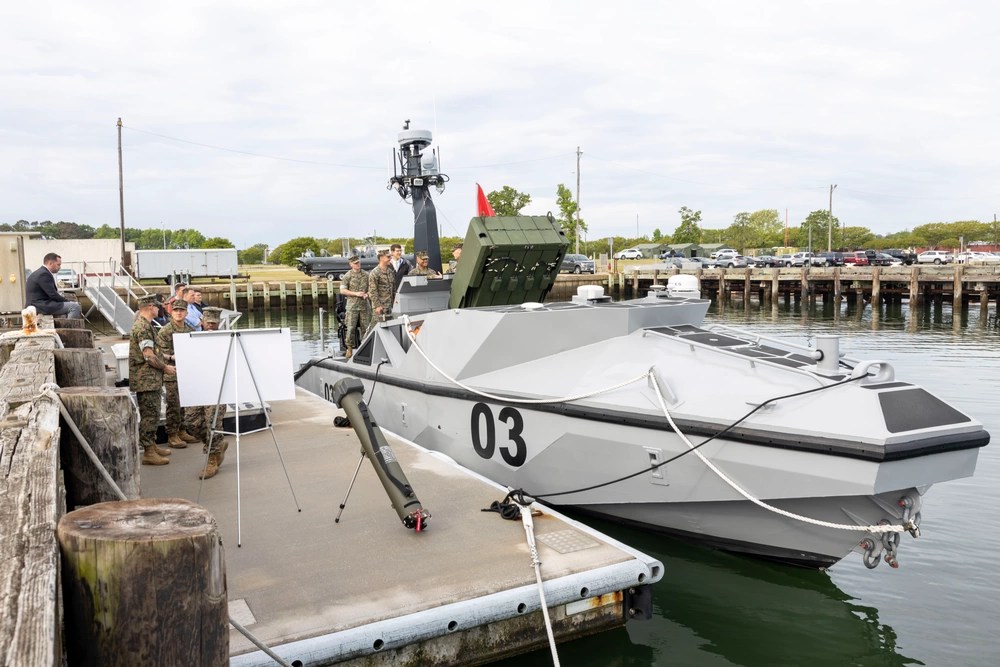The United States (US) has unveiled loitering munitions that can be swarm-launched for naval use from autonomous Unmanned Surface Vessels (USV).
Russia’s 20,000 Defense Workers “Missing In Action”; Its Capability To Produce Cutting-Edge Weapons Exhausted
Kamikaze drones have evolved as defining weapons in the ongoing Russia-Ukraine war and are expected to impact a possible conflict between the two superpowers in the Western Pacific.
The US Marine Corps Recently revealed its Long-Range Unmanned Surface Vessel (LRUSV) that can launch the Hero-120 loitering munitions.
These tactical systems, along with the larger supporting strategic platforms like aircraft carriers, warships, fighter bombers, and anti-access/area-denial (A2/AD), would play out in a distinctive ‘home’ versus ‘away’ scenario.
Here China is comfortably fighting from the home front while the US faces a series of logistical, technological, and doctrinal disadvantages as it reorients itself to fight a peer adversary.
Marine Corps Sea Drones Launching Loitering Munitions
Fleet Marine Force Atlantic (FMFLANT) released photographs of the LRUSV with the Hero-120 launcher last week. The LRUSV has been designed by the company Metal Shark.
The Marine Corps expects to employ the LRUSV “primarily as an intelligence, surveillance, and reconnaissance platform. (It can also be) capable of extended travel and transporting loitering munitions that accurately track and destroy targets on sea or land,” said a press release from the USMC.
The introduction of the platform comes amid the USMC fine-tuning the operations of its Marine Littoral Regiments (MLR) and the Expeditionary Advanced Base of Operations (EABO) concept.
The plan involves small, mobile, hard-to-detect island-hopping Marines based on friendly islands controlled by the Philippines or Japan, undertaking anti-shipping, anti-air fires on Chinese warships and planes.

USMC & US Navy Key Combatants
Working as a small part of the US Navy’s Distributed Maritime Operations (DMO) strategy, the goal is to spread out, coordinate and hit China inside the A2/AD bubble.
According to a report in The Drive, the version of the Hero-120 the USMC is acquiring is the service-specific Hero-120 OPF. The Hero drones are developed by the Israeli company UVision.
While it remains unclear how it might differ from the standard model, UVision’s website says the Hero-120 has a maximum range of at least 37 miles (60 kilometers) and an airborne endurance of around 60 minutes. The basic Hero-120 also has a high-explosive warhead weighing about 4.5 kilograms (10 pounds).
Like most current kamikaze drone systems, Hero-120’s sensor suite too indicates it has secondary surveillance and reconnaissance capabilities. They can be flown back and retrieved if the operator aborts the attack on a target.
How Will They Be Used
Precisely how Hero-120s would be controlled after launch from an LRUSV is not entirely clear. Without any personnel on the boats, the operator in the loop would have to be at a separate location. The loitering munition’s feed could be relayed through the data-sharing suite on the LRUSV, such as a satellite datalink.
Alternatively, control of the loitering munition could be transferred or relayed to those closer to the target area, either on the ground or riding on other ships or aircraft following launch.
The USMC demonstrated this during a test in 2022 that saw control of a bigger Hero-400 pass between personnel at the launch site on the ground and Marines flying in a UH-1Y Venom helicopter and riding in an unspecified watercraft below.

“Other Marine aircraft, including AH-1Z Viper attack helicopters and MV-22 Osprey tilt-rotors, could potentially be used in this role,” the Drive further said.
But the utility of small loitering munitions in naval surface warfare with a peer adversary too is questionable, given their asymmetric nature and orientation.
The most realistic scenario is the USN’s Arleigh Burke-class destroyers trying to hunt PLAN’S Type 055 or Type 052 ‘C’ or ‘D’ and fire salvos of Harpoon anti-ship missiles while LRUSVs use the Hero-armed LRUSVs to saturate the Chinese warship’s active radars.

Seeing swarms of LRUSVs and Hero loitering munitions will force PLAN warships to engage their close-in weapons systems (CIWS), sparing American Tomahawks the wall of 25mm rounds from the Gatling guns.
Another possible use could be against Chinese civilian fishing militias, which have long been assessed to be used to swarm, surround, confuse, and distract target vessels.
Numerous Plans In The Pipeline
With details on the larger acquisition, numbers, and configuration still being sketchy, these would be informed guesses until future exercises, drills, and tears reveal how the ‘system of systems’ fits into the overall scheme.
Overall, in cooperation with the Navy, the Marines are still exploring how they will use their new LRUSVs, with and without Hero-120s.
Any drone involvement will require high training and coordination between USMC units and USN ships to develop the right tactics.
The USMC is determining “the correct echelon of command” for these USV drone boats as part of its new Marine Littoral Regiments (MLR) experiments.
“Based on MLR experimentation (the USMC) is figuring out the right echelon of command (MLR, Division, or MEF) for the LRUSV and where it is best postured (Hawaii, Guam, Okinawa, or other),” according to a May 2022 update from the service on the implementation of its new overarching Force Design 2030 restructuring plans.
- The author can be reached at satamp@gmail.com
- Follow EurAsian Times on Google News




